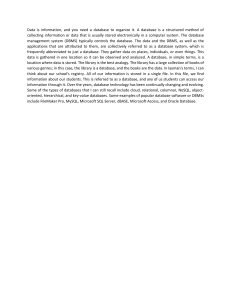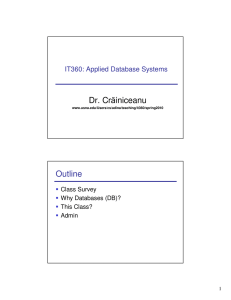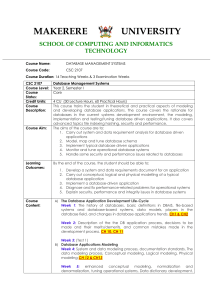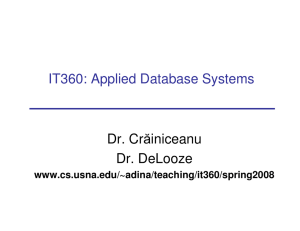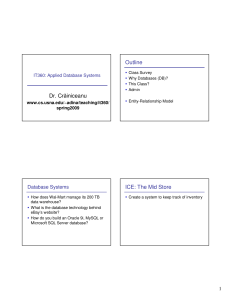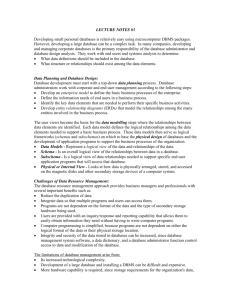ch01_introduction_to_database
advertisement
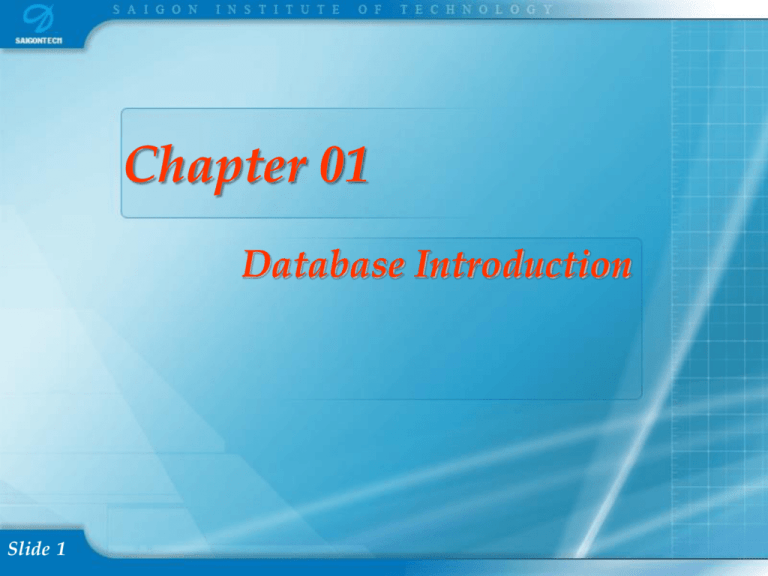
Chapter 01 Database Introduction Slide 1 Content I. Storing Student Information Problem II. Using Database 1. Databases and their Characteristics 2. Database Examples. 3. Components of a Database System. 4. Database Design Slide 2 I. Storing Student Information Problem A university need store its student information, lists of classes, student’s grades. • Each student has the following information: Student Number, Student Name, Email Address • A class has Class Number, Name, Term. • Grade information includes Student Number, Class Number, Grade. All information needs to be computerized and stored logically. We need a persistent storage. This storage must also be reliable. Slide 3 II. Using Database The purpose of a database is to help people track things (data). Slide 4 1. Databases and their Characteristics 1.1 Databases store data in tables. 1.2 All databases throughout the world, store instances in rows and characteristics in columns. Slide 5 1.3 A note on Conventions Table names in Capital letters. Column names in Capital of first letter. 1.4 A Database Has Data and Relationships 1.5 Summary: Database store data in tables, and they represent the relationships among the rows of those tables. Slide 6 2. Database Examples Single-User Database Applications Multiuser Database Applications E-commerce Database Applications Reporting and Data Mining Database Applications Slide 7 3. Components of a Database System 3.1 Applications 3.2 SQL (Structured Query Language) 3.3 The DBMS (Database Management System) 3.4 Programming Languages Slide 8 3.1 Applications are computer programs that users interact with directly. 3.2 SQL (Structured Query Language) is an internationally recognized standard language that is understood by all commercial database management system products. Slide 9 3.3 The DBMS (Database Management System) Create, processes, and administers the database. A DBMS is a large of complicated product and few organizations write their own DBMS program. Examples: Microsoft SQLServer, Oracle, IBM DB2, … Slide 10 3.4 Programming Language • Desktop applications: Microsoft: Visual Basic, C++, VB.NET, C#. Borland: Delphi Open Source: Java • Web applications: Microsoft: ASP, ASP.NET Open source: PHP, JSP, … Slide 11 4. Database Design 4.1 Database Design from Existing Data 4.2 Database Design from New Systems Development 4.3 Database Design from Redesign Slide 12 4.1 Database Design from Existing Data The first type of database design involves databases that are constructed from existing data Slide 13 This is an important decision, and based on a set of rules known as normalization (which is covered in Chapter Three) Slide 14 4.2 Database Design from New Systems Development The second way that databases are designed is from the development of new information systems Slide 15 4.3 Database Design from Redesign Database redesign is covered in Chapter Eight, after coverage of SQL in Chapter Seven Slide 16 Slide 17
